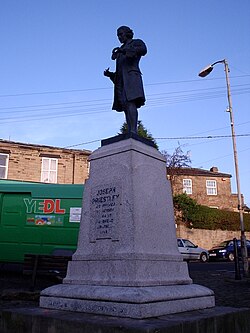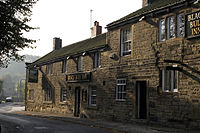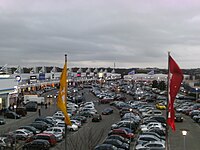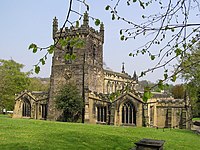Birstall, Yorkshire
| Birstall | |
| Yorkshire West Riding | |
|---|---|
 Birstall Market Place | |
| Location | |
| Grid reference: | SE241242 |
| Location: | 53°43’55"N, 1°39’36"W |
| Data | |
| Population: | 16,298 (2011) |
| Post town: | Batley |
| Postcode: | WF17 |
| Dialling code: | 01924 |
| Local Government | |
| Council: | Kirklees |
| Parliamentary constituency: |
Batley and Spen |
Birstall is a large village in the West Riding of Yorkshire; historically is was part of the Heavy Woollen District. It is found about six miles south-west of Leeds and situated close to the M62 motorway. The village is situated between Leeds, Bradford, Huddersfield and Wakefield.
History
Birstall's name is derived from the Old English byrh and stall meaning a fortified site,[1] which refers to an ancient hill fort which would have been found high above the village.
The hill fort iwould have been above the village, to one side of the present-day Raikes Lane, which heads towards Gildersome, and on to Leeds. In prehistoric days, trackways ran in various directions from one British settlement to another, one such settlement being on the top of Birstall Hill.
Following the course of Fieldhead Lane towards Drighlington is the Roman road of Tong Street. This location would give Birstall a great geographical advantage, making it within easy reach of the main thoroughfares of ancient Yorkshire. A Roman tiled mosaic was unearthed at Birstall Smithies, a former early industrial slag smelting site, during excavations in 1965. This and a hoard of Roman coins discovered at the foot of Carr Lane, on what was then Birstall Recreation Ground indicate quite succinctly as to the prehistoric origins of Birstall. These coins, which were discovered in the 18th century, dated from 192 to 268 AD.
A quarter of a mile up the hill from Birstall on Leeds Road, there was once a Roman watch tower. This observation point was built on the ridge or "brae" of the hill. One side overlooked the Birstall area, while the other looked downwards from Howden Clough and the valley towards upland Morley. This watchtower was known in the early 20th century to the local inhabitants as the Brass Castle, a corruption of Brae Castle. It followed the line of other such structures built in this part of the West Riding, atop prominent projecting ridges.
The town is not mentioned in the Domesday Book. Later, the village is alluded to as one of two settlements in Gomersal. Pigot's National Commercial Directory for 1828–29 listed it as one of the four villages which make up the township of Gomersal.
Birstall is the birthplace of Joseph Priestley, the discoverer of oxygen. Priestley was tutored extensively by the then Vicar of Birstall, an Edinburgh man with a keen interest in science. He was also a pupil at Batley Grammar School for Boys, founded in 1612 by the Rev. William Lee. The school still remains on Carlinghow Hill, approximately one mile from Birstall.
Also born here was John Nelson, a stonemason who was converted by John Wesley to Methodism whilst working in London and who returned to Birstall and became one of Wesley's most important preachers.
Birstall was prosperous before the Industrial Revolution, being within a small area that was a centre for the white cloth industry. However, the Industrial Revolution saw extensive growth, and the architecture of the period still dominates today. The wider area became known as the Heavy Woollen District, although the decline in textile production has led to a decline in its usage; it is still used in local sport, however. Of this period is the cobbled marketplace with a statue of Priestley, which was erected in 1912 by public subscription and sculpted by Frances Darlington.[2]
On 16 June 2016, the local member of parliament Jo Cox was shot and stabbed in Birstall outside the library where she was due to hold a surgery for local constituents. She later died of her injuries.[3]
Community
Birstall has grown substantially because of the expansion of Leeds, becoming an exburb of a more urban nature.
The village has retail areas adjacent to Junction 27 of the M62, Birstall Shopping Park.
Birstall contains a triangular-shaped Victorian marketplace, which replaced an earlier market on High Street in the Georgian area of the village. Market day is Thursday.
The Chamber of Trade organise the annual Christmas lights with a big switch on event on the last Tuesday in November.
Landmarks
Birstall's St Peter's Church dates to the time of Henry VIII, although the original tower is much earlier and may have been part of the original "Burgh Stall" or "Fortified Place". A family reconstitution of the parish registers of St Peter's, Birstall (1595–1812) was undertaken by Harvey Thwaite, and is one of the group of twenty-six family reconstitution studies that have been extensively used by the Cambridge Group for the History of Population and Social Structure.
Close to Birstall is Oakwell Hall, an Elizabethan manor house romanticised by Charlotte Brontë as 'Fieldhead' in her novel Shirley.
An 18th-century windmill stands in the grounds of Windmill Church of England Primary School.
The Black Bull Inn is situated behind St Peter's Church on Kirkgate. Its upstairs room was once used as a magistrate's court for Birstall and Gomersal, and is now Grade II listed.[4]
Outside links
| ("Wikimedia Commons" has material about Birstall, Yorkshire) |
- Upper Birstall Railway Station
- Lower Birstall Railway Station
- Birstall News
- Oakwell Hall
- St Peters Church, Birstall
References
- ↑ The Cambridge Dictionary of English Place-Names, edited by Victor Watts Cambridge University Press 2004.
- ↑ Mason, Patrick. "Joseph Priestley". https://www.ypsyork.org/resources/yorkshire-scientists-and-innovators/joseph_priestley/.
- ↑ "Jo Cox MP dead after shooting attack". BBC. https://www.bbc.co.uk/news/uk-england-36550304.
- ↑ Burnett, Alan. "34 : The Black Bull Inn, Birstall". http://greatyorkshirepubs.blogspot.com/2011/01/34-black-bull-inn-birstall.html.


